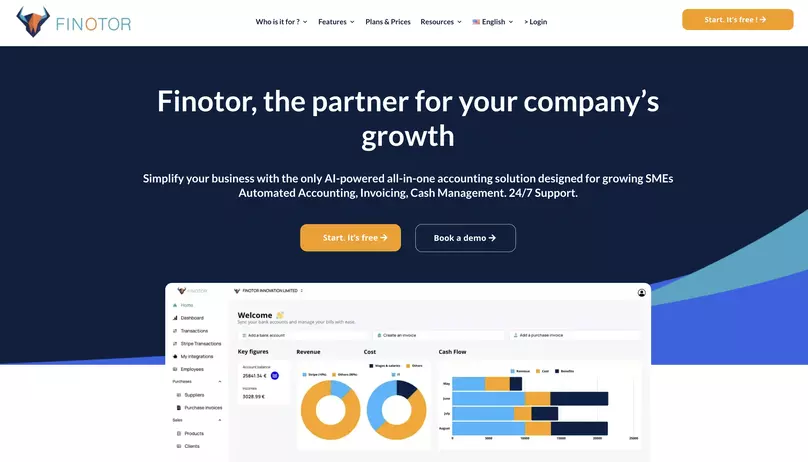Contents
When launching an online store, the thrill of those first sales can quickly overshadow the looming complexities of ecommerce accounting. Yet, as many seasoned entrepreneurs will attest, navigating this maze of numbers can be the thin line between success and failure. This article dives deep into why ecommerce accounting is more than just a necessary evil—it’s a pivotal element that could be silently eroding your business’s foundation.
In the exciting initial stages of starting an ecommerce venture, it’s easy to get caught up in the allure of branding and marketing, neglecting the less glamorous, yet critical, aspects of business management. Accounting, often viewed as the tedious backbone of fiscal control, emerges as a silent determinant of your business’s sustainability and growth. Without a solid grasp of ecommerce accounting practices, you might find yourself facing unexpected tax burdens, mismanaged cash flows, and pricing models that inadvertently throttle profitability.
This discussion is designed to shift your perspective, illustrating not only the challenges but also the strategic opportunities that proficient bookkeeping presents. By understanding the intricacies of ecommerce accounting, you can prevent it from becoming the Achilles’ heel of your business. Let’s explore how mastering these financial nuances can transform accounting from a mere obligation to a potent tool for business optimization.
Table of Contents
- Understanding Ecommerce Accounting
- Common Pitfalls in Ecommerce Bookkeeping
- Strategic Pricing: More Science Than Art
- Managing Cash Flow in Ecommerce
- Leveraging Finotor for Financial Masterye
- Conclusion: Turning Accounting into Your Strategic Advantage
Understanding Ecommerce Accounting
Ecommerce accounting transcends the basic tracking of numbers and transactions. It requires a sophisticated approach, blending precision with strategic foresight to navigate the unique complexities of the digital marketplace. This form of accounting differs markedly from traditional retail accounting, primarily due to the fast-paced nature of ecommerce, its diverse sales channels, and expansive international reach.
1. Multi-Currency Transactions: One of the standout challenges in ecommerce is dealing with multi-currency transactions. As businesses reach global markets, transactions can involve numerous currencies, each with fluctuating exchange rates. This complexity necessitates robust accounting software and practices that can accurately convert and report financials in the business’s base currency while accounting for exchange rate gains or losses. Entrepreneurs need to ensure compliance with the accounting standards of each currency’s country, adding another layer of complexity to financial management.
2. Shipping and Handling Costs: Calculating accurate shipping and handling costs is another critical aspect of ecommerce accounting. These costs can vary widely depending on the product, destination, and delivery method. Additionally, shipping costs can significantly impact the pricing strategy and overall profitability of the products sold online. Effective ecommerce accounting systems must be able to allocate these costs accurately to each product, ensuring that the financial impact of shipping and handling is properly reflected in the cost of goods sold (COGS).
3. Tax Obligations Across Regions: Managing tax obligations is particularly challenging for ecommerce businesses due to their ability to reach customers in different states and countries, each with its own tax regulations. Sales tax, value-added tax (VAT), and other forms of taxation must be calculated and applied correctly based on the location of the customer. Failure to comply with regional tax laws can lead to significant legal and financial penalties. It’s crucial for ecommerce businesses to have a system that automatically updates and applies the correct tax rates during the checkout process.
In conclusion, understanding ecommerce accounting means mastering these specialized areas to ensure financial accuracy and regulatory compliance. The ability to handle these complexities not only safeguards the business from potential fiscal pitfalls but also positions it for sustainable growth and profitability in the competitive global market. Ecommerce entrepreneurs must equip themselves with the necessary tools and knowledge to turn these accounting challenges into advantages.
Common Pitfalls in Ecommerce Bookkeeping
Effective ecommerce bookkeeping demands meticulous attention to detail and rigorous processes. However, even the most vigilant businesses can fall into common traps that compromise their financial health. Recognizing and addressing these pitfalls is essential to maintaining accurate records and making informed decisions.
Overlooking Small Errors
In the intricate world of ecommerce accounting, small discrepancies can cascade into significant issues. A minor error in data entry, such as a mistyped figure or a duplicated transaction, can skew your entire financial analysis. This might lead to misguided strategic decisions, such as inappropriate budget allocations or faulty pricing strategies, which can have long-lasting repercussions on business health. Implementing robust double-checking mechanisms and utilizing accounting software and ecommerce accounting software like Finotor with a free account to begin, that offers error-checking features are critical steps in mitigating this risk.
Inconsistent Inventory Tracking
Inventory management is a critical component of ecommerce that directly impacts bookkeeping accuracy. With products constantly being bought and sold, keeping track of inventory levels becomes challenging yet indispensable. Inaccurate inventory tracking can lead to two major issues: overselling, which erodes customer trust when orders cannot be fulfilled, and stockouts, which result in missed sales opportunities and potential revenue loss. Both scenarios can damage a company’s reputation and its bottom line. Utilizing advanced inventory management systems that integrate real-time tracking and predictive analytics can help maintain accurate inventory records and forecast future inventory needs more effectively.
Neglecting Regular Reconciliations
Regular financial reconciliations are the backbone of sound ecommerce bookkeeping, serving as a check against discrepancies and potential fraud. In the fast-paced ecommerce sector, it’s easy for this critical task to be overlooked or rushed. Skipping regular reconciliations can lead to unrecognized errors accumulating, from unintentional misentries to deliberate fraud, which can silently cripple a business’s financial standing. Establishing routine reconciliation processes, ideally on a monthly basis, ensures that all financial activities are accurately recorded and that the business remains on solid fiscal ground. Additionally, employing automated reconciliation tools can streamline this process, reducing the labor intensity and increasing the reliability of the checks performed.
By vigilantly addressing these common pitfalls, ecommerce businesses can enhance their financial practices, leading to more reliable bookkeeping and healthier financial management. This proactive approach not only helps in maintaining accurate records but also supports strategic decision-making, ultimately contributing to the business’s success and sustainability in the competitive ecommerce landscape.
Strategic Pricing: More Science Than Art
In the complex and competitive world of ecommerce, setting the right price for your products is a critical factor that can significantly influence your business’s success. This process, often perceived as more of an art form, is indeed grounded in science—requiring a strategic approach that balances market demands, cost considerations, and customer value perception.
Understanding Market Dynamics
Effective pricing strategies start with a comprehensive analysis of the market. This involves researching competitor pricing but goes much beyond to include understanding broader market trends, consumer purchasing power, and seasonal fluctuations. For ecommerce businesses, this means not only keeping an eye on direct competitors but also on alternative solutions available to consumers. Advanced market analysis tools can provide real-time data and insights into competitor strategies, helping you stay competitive without necessarily entering a price war.
Cost Analysis
A fundamental aspect of pricing strategy is understanding all the costs involved in bringing a product to market. This includes production costs, shipping, handling, taxes, and any other overheads. It’s crucial to ensure that your pricing covers these costs while still offering room for a profitable margin. Cost-plus pricing, where a fixed percentage is added to the cost of producing a product, is a straightforward method but may not always align with market expectations or consumer willingness to pay. Thus, integrating a more nuanced approach that considers both cost and perceived value is essential.
Leveraging Data Analytics
Data analytics plays a pivotal role in modern strategic pricing. With access to detailed analytics, businesses can experiment with different price points and special offers in a controlled manner. This could involve A/B testing different prices to see which garners better conversion rates or using promotional pricing strategically to attract new customers and reward loyalty without eroding brand value. Tools like price optimization software can analyze historical sales data, consumer behavior, and elasticity of demand to recommend the most effective pricing strategies.
Customer Value Perception
Understanding how customers perceive the value of your products is crucial in setting prices that they are willing to pay. This perception is influenced by factors such as brand reputation, product quality, customer service, and the overall shopping experience. Surveys, customer feedback, and engagement metrics can provide insights into customer satisfaction and how much value customers place on your offerings. Pricing should reflect this perceived value, positioning your products as solutions that meet or exceed customer expectations.
Dynamic Pricing Models
In the digital age, dynamic pricing models offer a way to adjust prices in real-time based on market conditions, inventory levels, and customer demand. This approach allows ecommerce businesses to be agile, adapting prices in response to external factors such as a competitor’s sale or changes in supply and demand. While dynamic pricing can significantly increase profitability, it must be managed carefully to maintain trust and avoid alienating customers.
In conclusion, strategic pricing in ecommerce is indeed more science than art. It requires a thorough understanding of numerous variables and a calculated approach to testing and implementing price changes. By harnessing the power of data analytics and understanding market dynamics and customer value perception, ecommerce businesses can develop pricing strategies that not only cover costs but also maximize profits and enhance customer satisfaction.
Managing Cash Flow in Ecommerce
Cash flow management in ecommerce is critical, often mirroring the unpredictability of a rollercoaster ride. The inherent variability in sales—where peaks are often followed by inevitable troughs—demands astute financial stewardship to maintain operational stability. Effective cash flow management is not merely about surviving the lows but strategically capitalizing on the highs to foster sustainable growth and stability.
Finotor Collection of Receivables
In ecommerce, where transactions occur rapidly, the Finotor collection of receivables becomes a crucial element of cash flow management. Delayed payments can severely disrupt cash flow, particularly for small to medium-sized enterprises that rely on consistent cash inflow to meet operational expenses. Implementing automated payment systems can significantly reduce the delay in receivables. These systems ensure that payments are processed immediately upon purchase, and reminders are sent automatically for any delayed payments, thereby minimizing the time between sales and cash collection.
Wise Management of Payables
Just as important as managing receivables is the strategic management of payables. Wise payables management involves negotiating favorable payment terms with suppliers to align better with your cash flow cycles. For instance, securing extended payment terms during slower sales periods can provide much-needed liquidity, while taking advantage of early payment discounts during higher sales periods can reduce overall costs. Furthermore, utilizing electronic payment systems can help in scheduling payments exactly when they are due, ensuring that cash remains in your business for as long as possible without incurring late fees.
Maintaining a Buffer of Cash Reserves
One of the most prudent strategies in managing cash flow fluctuations is maintaining a buffer of cash reserves. This reserve acts as a financial safety net during downturns or unexpected challenges, such as a sudden need for inventory replenishment or an unforeseen operational expense. Determining the appropriate size of cash reserves typically involves analyzing historical cash flow patterns and identifying potential future risks that could impact liquidity. It’s generally recommended to keep enough reserves to cover at least a few months of operating expenses.
Implementing Cash Flow Forecasts
Additionally, regular cash flow forecasting can enhance your cash management strategy. By projecting future cash inflows and outflows, you can anticipate and plan for periods of cash shortage, ensuring that the business can continue to operate smoothly without disruption. This proactive approach involves detailed tracking and analysis of all cash-related transactions, which can be facilitated by sophisticated cash management software that offers insights into trends and potential cash flow scenarios.
Leveraging Technology for Efficiency
Ecommerce businesses can further benefit from leveraging technology solutions that integrate inventory management with financial software. This integration allows for real-time visibility into both stock levels and financial metrics, enabling more accurate and dynamic cash flow management. Technology can help automate many processes that traditionally consume a lot of time, such as inventory tracking, invoice generation, and credit control, thereby improving overall efficiency.
In conclusion, managing cash flow in ecommerce requires a combination of strategic planning, wise financial practices, and the effective use of technology. By ensuring Finotor collection of receivables, wise management of payables, maintaining adequate cash reserves, and utilizing cash flow forecasts, ecommerce businesses can navigate the ups and downs of sales cycles more smoothly and maintain a strong financial footing in the competitive digital marketplace.
Leveraging Finotor for Financial Masterye
In the complex activity of ecommerce, managing finances efficiently can be the key to sustaining and scaling a business. Finotor, as ecommerce accounting software, stands out as an invaluable tool for those aiming to simplify and enhance their financial operations. This comprehensive ecommerce accounting software is designed to automate routine bookkeeping tasks while providing deep insights into a company’s financial health through intuitive dashboards and detailed reports. Let’s explore how integrating Finotor can transform your ecommerce accounting practices.
Automation of Bookkeeping Tasks
Finotor excels in automating the repetitive and time-consuming tasks associated with bookkeeping. By automating processes such as transaction entries, expense tracking, and invoice management, Finotor not only saves valuable time but also reduces the likelihood of human error. This level of automation ensures that financial records are up-to-date and accurate, providing a reliable foundation for making critical business decisions.
Real-Time Financial Insights
One of the standout features of Finotor is its ability to provide real-time insights into financial trends. Through customizable dashboards and analytics, ecommerce business owners can monitor key financial indicators such as revenue growth, profit margins, and expense trends at a glance. This instant access to financial data allows for agile decision-making. For example, if a sudden dip in cash flow is detected, business owners can quickly investigate the cause and take corrective actions, such as adjusting marketing spends or revisiting supplier contracts.
Informed Decision-Making
With Finotor, decision-making is underpinned by robust, data-driven insights. The software’s reporting capabilities allow you to delve deeper into financial details, offering breakdowns of sales by product line, customer demographics, or even geographic regions. This granularity helps you identify which aspects of your business are performing well and which may require strategic adjustments. Moreover, scenario planning tools within Finotor can help forecast the financial impacts of different business decisions, enabling owners to simulate potential outcomes before committing to a course of action.
Compliance with Tax Regulations
Navigating the maze of tax regulations across different jurisdictions can be daunting for any ecommerce business operating on a global scale. Finotor simplifies this complexity by ensuring that all financial practices are compliant with local tax laws. It automatically updates tax rates and regulations, applying them accurately to transactions. This not only helps in avoiding costly legal penalties but also in managing international sales more effectively. Additionally, Finotor can aid in preparing and filing tax returns, making tax season less stressful.
Enhancing Collaboration
Finotor also facilitates better collaboration within your financial team and with external stakeholders like accountants or financial advisors. Its cloud-based platform allows for secure access to financial data from anywhere, enabling team members to work collaboratively and remotely. This accessibility is particularly beneficial in today’s digital age, where flexibility and connectivity can significantly boost productivity and response times.
In sum, leveraging Finotor for your ecommerce business can lead to substantial improvements in financial management. By automating mundane tasks, providing real-time financial insights, facilitating informed decision-making, ensuring compliance with international tax regulations, and enhancing team collaboration, Finotor not only streamlines financial operations but also empowers business owners to take their ecommerce ventures to new heights. With Finotor, financial mastery becomes not just an aspiration but an achievable reality.
Conclusion: Turning Ecommerce Accounting into Your Strategic Advantage
Instead of viewing ecommerce accounting as just another chore, savvy entrepreneurs see it as a strategic asset. By mastering ecommerce accounting, you not only safeguard your business against common financial pitfalls but also set the stage for informed, data-driven growth. Embrace these best practices, leverage tools like Finotor, and watch as accounting turns from a foe to an ally in your entrepreneurial journey.
Ecommerce accounting may not be glamorous, but it’s the backbone of your business’s financial health. Equip yourself with the right tools and knowledge, and you’ll find that these numbers have more to tell than just sums—they hold the secrets to your business’s longevity and success.










